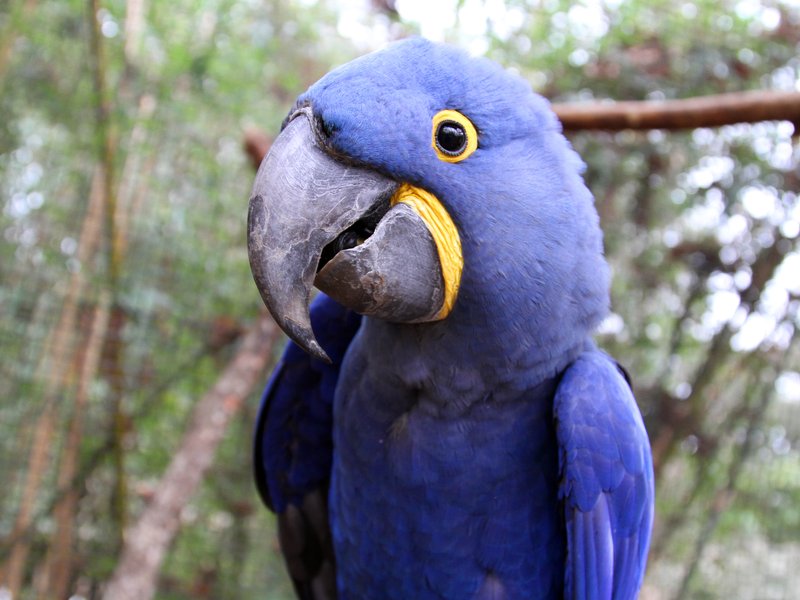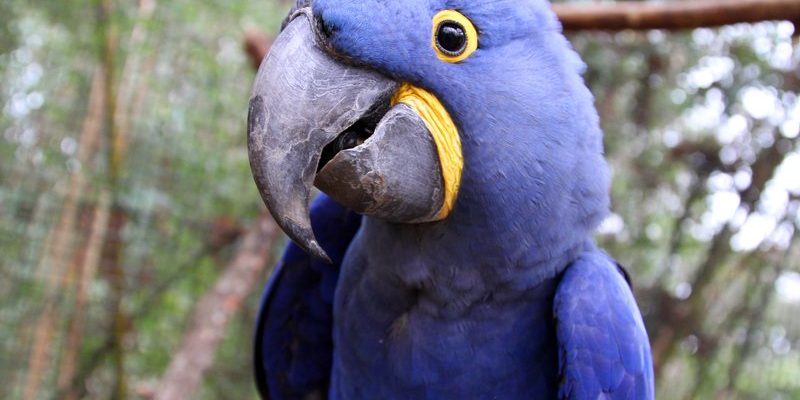
These birds are not just beautiful; they have fascinating behaviors and lifestyles that capture the hearts of many. Whether you’re a bird enthusiast or just curious about nature’s wonders, learning about the Hyacinth Macaw can be incredibly rewarding. So, grab a cup of coffee, and let’s explore some of the most interesting facts about these unique creatures!
1. Stunning Size and Color
One of the first things you’ll notice about the Hyacinth Macaw is its size. These birds can reach lengths of about 3.3 feet from beak to tail. That’s longer than some small dogs! Weighing around 2 to 4 pounds, their robust bodies are complemented by stunning cobalt blue feathers, which shine like a precious gem in the sunlight.
But it’s not just their size that makes them striking. Their bright yellow eye rings and vibrant yellow patches on their wings and tails create a beautiful contrast against their blue plumage. These colors serve a purpose too! The vibrant hues help them communicate with each other in the wild while also acting as camouflage among the trees. Here’s the thing: their beauty is not just for show—it plays an essential role in their survival.
2. Native Habitat
Hyacinth Macaws are native to the lush rainforests of South America, particularly in Brazil, Paraguay, and Bolivia. They thrive in habitats with tall trees, where they can easily find their favorite treats. Think about the tallest trees in your local park or forest—now imagine these magnificent birds perched high up, munching on nuts and seeds.
These birds favor the Brazil nut tree and the palm trees found in their natural habitats. Their strong, curved beaks are perfectly designed for cracking open tough nuts. They can exert a bite force of about 200 pounds per square inch—yikes! That’s strong enough to break open some of the toughest shells found in nature.
3. Diet and Feeding Habits
Speaking of food, a Hyacinth Macaw’s diet mainly consists of fruits, nuts, and seeds. They are particularly fond of the fruits of the acuri palm, which are not just delicious but also important for their health. Their beaks not only help them crack nuts, but they also assist in peeling fruit. Honestly, they have some serious skills in the kitchen of the rainforest!
You might be wondering how they find food. These birds often work in pairs or small groups to forage. They’ll communicate through various vocalizations, from soft squawks to loud screeches, alerting each other to food sources or potential dangers. This social behavior is vital for their survival, as it ensures they always have someone looking out for them.
4. Social Creatures
Hyacinth Macaws are known for their playful and affectionate nature. They are incredibly social creatures, often forming strong bonds with their mates and family members. In the wild, they can often be seen cuddling, preening each other, and playing. It’s a beautiful sight that showcases their strong family ties.
In fact, once they find a mate, they often stay together for life! This loyalty extends to their family groups as well. Young macaws remain with their parents for several years before venturing off to find their own mates. You could say they have a solid support system in place, making family time a cherished affair!
5. Lifespan and Longevity
If you’re thinking of getting a Hyacinth Macaw as a pet, you’ll need to plan for a long commitment. These birds can live up to 50 years in captivity and even longer in the wild. It’s like having a feathered family member for half a century! Their long lifespan is partly due to their diet, social structure, and natural behaviors.
In captivity, their lifespan can be influenced by diet, environment, and care. Providing a balanced diet, plenty of social interaction, and a stimulating environment can help ensure these birds live long, healthy lives. Just remember, they require a lot of attention and love!
6. Conservation Status
Sadly, the Hyacinth Macaw is classified as “Vulnerable” on the IUCN Red List. Habitat loss and illegal trapping for the pet trade are significant threats to their population. Many people admire their beauty and want them as pets, which has led to a decline in their numbers in the wild.
Efforts are being made to protect their habitats and raise awareness about their conservation. Various organizations are working hard to preserve their environment and educate people about the importance of keeping these birds wild. Here’s the thing: every little effort counts when it comes to protecting these amazing creatures!
7. Unique Vocalizations
Hyacinth Macaws are known for their loud and distinctive vocalizations. You might think of parrots as talkative, but these birds have their own unique way of communicating. Their calls range from low rumbles to loud squawks that can carry for miles in the dense forest.
These vocalizations serve different purposes, such as alerting their flock, attracting mates, or warning about predators. Their ability to communicate effectively is crucial for their survival in the wild. It’s almost like they have their own language, complete with tones and pitches, which adds another layer to their fascinating lives.
8. Intelligent and Playful
Hyacinth Macaws are incredibly intelligent birds. They are known for their problem-solving abilities and playful nature. Think about it—if you had a beak that could crack nuts, you’d probably want to play with it too! Their intelligence shines through in their ability to manipulate toys, explore their surroundings, and learn new tricks.
In captivity, they can be trained to do fun activities, like playing games with their owners or learning commands. Providing them with interactive toys is essential to keep their minds stimulated. Without mental challenges, they can become bored and develop unwanted behaviors. So, give them plenty of opportunities to flex their mental muscles!
9. The Importance of Nesting Sites
When it comes to raising their young, Hyacinth Macaws prefer to nest in large tree hollows. These nesting sites are critical to their reproductive success. The female lays two to four eggs, which both parents help incubate. It’s a true team effort that reflects their strong family orientation.
Unfortunately, with deforestation, many of these nesting sites are disappearing. The loss of these natural habitats makes it harder for them to find safe places to raise their young. This is another reason why conservation efforts are so important. They need a safe environment to thrive and grow their families.
10. Why They Matter
Understanding the role of Hyacinth Macaws in their ecosystem is crucial. They are considered keystone species, meaning their presence helps maintain the structure of their environment. By feeding on nuts and seeds, they help disperse plant seeds across their habitat, promoting biodiversity.
Their decline can have a ripple effect on the entire ecosystem. Protecting these magnificent birds is not just about saving a pretty face; it’s about ensuring a healthy environment for countless other species. Each Hyacinth Macaw plays a part in the complex web of life, making their conservation even more critical.
In conclusion, Hyacinth Macaws are truly remarkable creatures with unique behaviors, stunning beauty, and essential roles in their ecosystems. Whether in the wild or as beloved pets, these birds remind us of the importance of connection—both with each other and with nature. So, if you ever spot one soaring through the sky, take a moment to appreciate the wonder they bring to our world.

